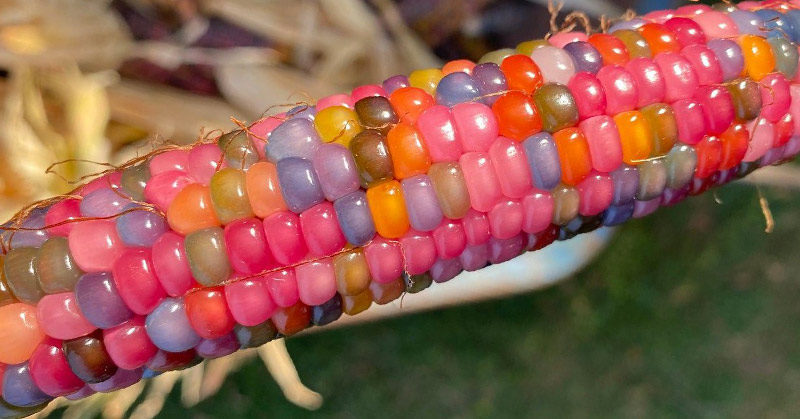“Glass Gem” corn went viral in 2012 when a photo of the rainbow-colored kernels was posted on Facebook. Imagine the excitement of peeling the husk of a corn of the cob to find the purple, pink, blue, red, and yellow of a kaleidoscope. You may not find rainbow corn at a farmer’s stand by the side of the road, but you can grow them yourself.
Creating Rainbow-Colored Corn from Cherokee Roots
Carl Barnes, a farmer from Oklahoma, began planting ancient varieties of corn as his way of connecting to his Cherokee heritage. These ancestral types have been lost to Native Americans when they were relocated into the area that is now Oklahoma in the 1800s. As Barnes began mixing different varieties of corn, multicolored cobs began being produced. This led to an exchanging of ancient seeds and creating friendships with people all over the country. Then, he chose the seeds of the most colorful cobs for the next crop.
Barnes displayed the Glass Gem corn at a native-plant gathering in the mid-1990s. One grower in particular, named Greg Schoen, was so excited about the new kind of corn Barnes gave him a few seeds. This marked the beginning of a close friendship.
Read: You can dig for your own rare gems in this gem mine
The First “Glass Gem” Corn
In the beginning, Schoen grew only small crops in New Mexico when he moved there in 1999. When he moved to Santa Fe in 2005, he planted more corn and crossed them with other varieties of more traditional corn. This mixing resulted in vibrant colors and patterns.
Schoen recalled an account where Barnes explained that the rainbow seeds originated from “Pawnee miniature popcorns with an Osage red flour corn and also another Osage corn called ‘Greyhorse’.” Schoen named the patterns and colors titles like ‘circus colors’, ‘true rainbow’, ‘deep blue’. [1]
“Glass Gems” was his name for the blue-green and pink-purple corn he had harvested in 2007. This was the original pattern that went viral in 2012.
Read: Cucamelons is the Most Adorable Superfood You Can Grow in Your Own Garden
Distributing the Rainbow Corn to Everyone
In 2019, Schoen shared his seeds with Bill McDorman, an owner of a seed company in Arizona called Seed Trust, who helped them become available for gardeners to grow them through a nonprofit Native Seeds. They are now available for purchase online.
One planter, Carol Fritzinger, describes husking the corn to be like Christmas morning.
“Oooh, this one’s a pink and purple variety,” she says to NPR, laughing as she peels back a husk to show the corn inside. “You just never know!”
She wants to share this stunning piece of nature with as many people as she could. “I want everyone to grow it,” Fritzinger says. “So I give as much seed away as people will take.” [2]
How to Grow Your Own Rainbow Corn
You can buy a packet of Glass Gem seeds for just a few dollars to plant in your own backyard. The seeds are accompanied by information about seed saving and corn pollinations. [3]
Each corn plant grows to about six feet tall on average, but it can rise up to nine feet. The ears are usually three to eight inches long. Like other kinds of corn, Glass Gem is best planted in the late spring when the soil is warm. Set the seeds in a sunny area and provide about an inch of water every week. The corn is ready for harvesting about 110 to 120 days after being planted.
For good pollination, plant the seeds around 6 inches (15cm) apart in blocks of at least three rows, (not one long row) digging about 1 inch (2.54 cm) into the ground.
Then bring out the camera! No rainbow corn is the same; each of them comes with their own pattern and color combinations. Every time you peel the husk, there’s a new surprise waiting underneath. Some are very rainbow-like, while others are mostly one shade of blue, red, or even almost white. [4]
How to Eat and Enjoy Rainbow Corn
Keep in mind that this corn shouldn’t be eaten right off the cob like regular corn. Glass Gem corn has a tougher outer layer and can only be eaten by grinding it into cornmeal or popping into popcorn. (Unfortunately, the popcorn isn’t multi-colored.) For popcorn, harvest the corn when it’s brown and dry. Then remove the husks and dry the corn further after taking it inside until the kernels fall off the ear.
If you’re especially interested in this corn for ornamental reasons, you can save the seeds of your favorite corn and replant those.
No matter how you decide to enjoy the harvest, Glass Gem corn is beautiful enough to plant just for the sake of it.
Keep Reading: Blue Java Banana: The Banana That Tastes ‘Just Like Vanilla Ice Cream’
References:
[1] “This Rainbow Corn Actually Exists. Here’s How.” Dina Spector. Business Insider. June 28, 2016
[2] “Glass Gem Corn: Poster Child For The Return To Heirloom Seeds.” Melissaa Sevigny. NPR. November 25, 2019
[3] Purchase Glass Gem Corn Seeds. Native Seeds Search.
[4] “’Rainbow’ Corn Took the Internet by Storm, and Now You Can Plant it In Your Own Garden.” Andrea Beck. Better Homes & Gardens. Feb 6, 2020

